
The buff ermine is a moth of the family Erebidae. It is sometimes placed in the genus Spilosoma. The species was first described by Johann Siegfried Hufnagel in 1766. It is found throughout the temperate belt of the Palearctic region south to northern Turkey, Georgia, Kazakhstan, southern Siberia, eastern Mongolia, Amur Region, China, Korea and Japan.

Euthalia aconthea, the common baron, often called simply baron, is a medium-sized nymphalid butterfly native to Sri Lanka, India and southeast Asia. It flies with stiff wing beats and often glides. The wing is not flapped very far below the horizontal.

Cepora nerissa, the common gull, is a small to medium-sized butterfly of the family Pieridae, that is, the yellows and whites, which is native to Sri Lanka, India, China, southeast Asia, and Indonesia.
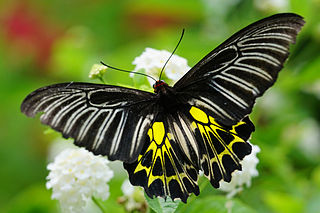
Troides aeacus, the golden birdwing, is a large tropical butterfly belonging to the swallowtail family, Papilionidae.

Losaria coon, the common clubtail, is a butterfly belonging to the swallowtail family, Papilionidae. The butterfly belongs to the clubtails, genus Losaria. It includes several subspecies and is found from the Nicobar Islands and Assam in India, east to Hainan in China, and south through Indochina, to Java and other islands of Indonesia and Bangladesh.

Byasa latreillei, the rose windmill, is a butterfly from the windmills genus (Byasa), found in various parts of Asia, comprising tailed black swallowtail butterflies with white spots and red submarginal crescents.

Delias pasithoe, the redbase Jezebel is a medium-sized butterfly of the family Pieridae, that is, the yellows and whites. The species is found in parts of South Asia and Southeast Asia. There has been some dispute for which species the specific name aglaja, used twice by Linnaeus in 1758, applies – the redbase Jezebel, or the dark green fritillary, a brush-footed butterfly. Here, Delias pasithoe is used for the redbase Jezebel, based on the replacement name proposed by Linnaeus himself.
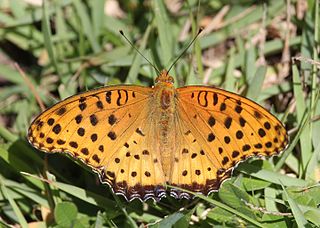
The Indian fritillary is a species of butterfly of the nymphalid or brush-footed family. It is usually found from south and southeast Asia to Australia.

Troides darsius, the Sri Lankan birdwing, is a species of birdwing butterfly found in Sri Lanka. It is the largest butterfly on the island and is also the national butterfly of Sri Lanka.

Spilosoma is a genus of moths in the family Erebidae originally described by John Curtis in 1825. A very heterogeneous group, it is in need of review by the scientific community, as certain species probably need reclassification into their own genera.

Colias erate, commonly known as the eastern pale clouded yellow, is a species of butterfly in the family Pieridae. It is found from south-eastern Europe, through Turkey over central Asia up to Japan and Taiwan. To the south, its range stretches to Somalia and Ethiopia. The species was first described by Eugenius Johann Christoph Esper in 1805.

Spilosoma clava is a species of moth of the family Erebidae. It was described by Alfred Ernest Wileman in 1910. It is found in Taiwan.

Spilosoma wilemani is a species of moth of the family Erebidae. It was described by Walter Rothschild in 1914. It is found in Taiwan and Japan's southern Ryukyu Islands.

Spilosoma fumida is a species of moth of the family Erebidae. It was described by Alfred Ernest Wileman in 1910. It is found in Taiwan.
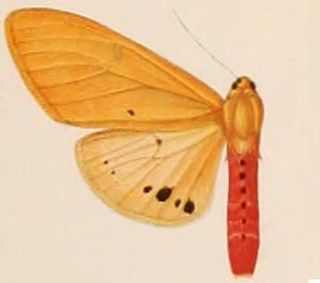
Spilosoma eldorado is a moth of the family Erebidae. It was described by Walter Rothschild in 1910. It is found in eastern India and Sri Lanka.
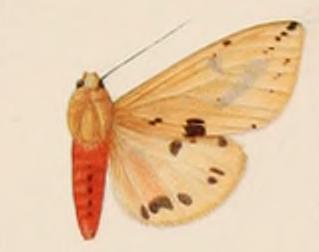
Spilosoma roseata is a moth of the family Erebidae. It was described by Walter Rothschild in 1910. It is found on Java in Indonesia.

Spilosoma alberti is a moth of the family Erebidae. It was described by Walter Rothschild in 1914. It is found on Papua New Guinea, where it is restricted to mountainous areas at high altitudes ranging from 1,200 to 2,150 meters.
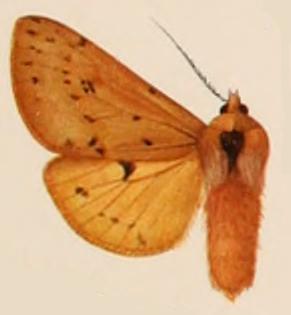
Spilosoma fraterna is a moth of the family Erebidae first described by Walter Rothschild in 1910. It is found on Papua New Guinea.
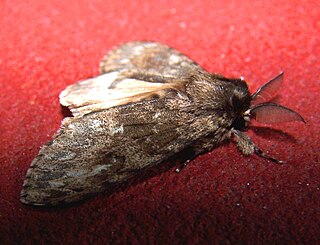
Lymantria serva, the ficus tussock moth or serva tussock moth, is a moth in the family Erebidae. It was described by Johan Christian Fabricius in 1793 and is found in Nepal, Sri Lanka, Assam in India and Yunnan in China. It is possibly also found in Taiwan and Hongkong, but these records might be Lymantria iris.
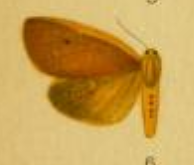
Spilosoma gynephaea is a moth in the family Erebidae. It was described by George Hampson in 1901. It is found in South Africa and Zimbabwe.


















